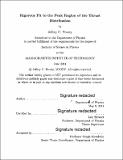Rigorous fit to the peak region of the thrust distribution
Author(s)
Prouty. Jeffrey C
DownloadFull printable version (5.757Mb)
Other Contributors
Massachusetts Institute of Technology. Department of Physics.
Advisor
Iain Stewart.
Terms of use
Metadata
Show full item recordAbstract
We continue the work of Abbate et al. in [1], in which a factorization formula for the thrust distribution in electron-positron collisions was developed in the framework of soft-collinear effective theory. We extend the analysis of thrust to the peak region of the distribution, in which a nonperturbative soft function encoding the effects of large-angle soft gluon radiation plays a significant role. We write the soft function as an infinite sum of basis functions and use a truncated version in our calculations, allowing us to fit for the basis coefficients ci with all available thrust data from center-of-mass energies Q = 35 to 207 GeV. To characterize the soft function independently of a particular parameterization, we present fit results for its cumulant moments, denoted [Omega]1, up to i = 4. We compute experimental uncertainties from the fits and theory uncertainties using a random scan in the space of the undetermined parameters of the theory. Our approach significantly improves the fit in the peak region, reducing the minimum X2/d.o.f. value from to 5.29 using the best fit form the tail region without fitting basis functions, to 1.23 using five basis functions. We find [Omega]1 = 0.387 ± (0.003)exp ±(0.026)pert GeV, indicating that the peak region determines [Omega] with considerably more precision than the tail. For the second cumulant moment, we find [Omega]'2 = 0.032 ± (0.002)exp ± (0.011)pert GeV2 . We also estimate the third and fourth cumulant moments, obtaining [Omega]'3 = [3.5 ± (0.7)expt ±(2.3)pert] x 10- GeV 3 and [Omega]'4 = [-0.7 ± (3 .8)exp ± (11.9)pert] X 10-4 GeV4.
Description
Thesis: S.B., Massachusetts Institute of Technology, Department of Physics, 2014. Cataloged from PDF version of thesis. Includes bibliographical references (pages 51-53).
Date issued
2014Department
Massachusetts Institute of Technology. Department of PhysicsPublisher
Massachusetts Institute of Technology
Keywords
Physics.